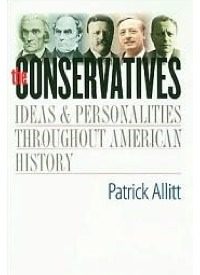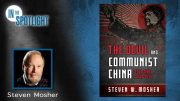
In his recently published sixth book, The Conservatives, Emory University professor Patrick Allitt undertakes his most comprehensive effort to date in writing the history of the modern conservative movement.
Such a task is by no means an easy one; the history is often a complex interweaving of personal histories and intellectual squabbles, complicated by regional identities. In the main, Dr. Allitt provides a helpful, and quite readable, treatment of this topic. Nevertheless, the book is marked by weaknesses, and perhaps biases, which mar the overall work.
One of the difficulties associated with writing a history such as Allitt has undertaken is to avoid degenerating into a mind-numbing catalog of names. The author does an admirable job of offering contextual details of the various strands which make up the tapestry of American conservatism leading up to World War II. For the most part, he permits the various politicians, writers, and other leaders surveyed to speak for themselves through carefully chosen quotations, and the works cited throughout the text could provide the careful reader with the titles of books for many years of further study. Allitt also does a scholarly job of providing the context of Northern and Southern conservative thought in the years between the framing of the U.S. constitution and the outbreak of the War Between the States, explaining why conservatives could disagree on such fundamental issues of early American history as slavery — and yet do so on the basis of shared principles. However, Allitt’s casting of the Civil War as “a conflict between two types of conservatism” appears to argue beyond the facts, and his own account of the conservatives of the age demonstrates that the conservatives were, as they usually are, far from a unified block on the decision to secede or to fight for the union, within their respective regions.
The work is disproportionately focused on the history of conservatism since World War II; nearly half the book is concerned with the period from 1945 until 2001. Since most readers will undoubtedly be most interested in the more recent period, the emphasis is understandable. Nevertheless, his treatment of early developments such as the New Humanism of Irving Babbitt and Paul Elmer More and the Southern Agrarian position articulated in I’ll Take My Stand provides sufficient context to understand later developments. However, the far more extensive treatment he provides of H.L. Mencken and Albert Jay Nock seems disproportionate to their actual intellectual or political relevance.
Given the significance of such conservative classics as Richard Weaver’s Ideas Have Consequences, Russell Kirk’s The Conservative Mind, and Eric Voegelin’s The New Science of Politics and Science, Politics, and Gnosticism, this reader was left wishing that Allitt could have done more to engage the critical significance of these books — and their authors. When the present writer was working for several conservative organizations “inside the Beltway“ during the 1980s and ‘90s, the influence of Russell Kirk, for example, was almost palpable: members of all the branches of the conservative movement read his books, and his lectures at the Heritage Foundation were well-attended. Allitt seems fixated on William F. Buckley, Jr. as virtually the ‘indispensable man’ in the history of post-War conservatism, but without the rallying power of books such as The Conservative Mind or Phyllis Schlafly’s A Choice, Not An Echo, and Barry Goldwater’s and L. Brent Bozell’s, The Conscience of a Conservative there would have been no one to rally.
Surprisingly, Allitt almost seems to disparage Kirk’s The Conservative Mind, one of the formative works of 20th-century conservatism, which he describes as “a wonderful mix of intellectual history and literary mythmaking. The Conservative Mind traces (or perhaps creates) a conservative lineage in the English-speaking world from Edmund Burke in the 1780s down to T. S. Eliot in Kirk’s day.” The irony, of course, is that Allitt’s own book essentially attempts to trace the same lineage, and is built around the notion that there are themes, trends, and certainly intellectual inheritances which are a continuity between the generations of conservatives in America — a notion that is first articulated in Kirk’s The Conservative Mind.
It must also be noted that Allitt’s treatment of The John Birch Society seems, to this writer, contemptuously dismissive. In light of the 50-year history of the JBS, with its nationwide activity, influential publishing efforts, undeniable influence on numerous political campaigns, and its sustained role in domestic and foreign policy discussions around the United States, it is hard to imagine writing a credible history of 20th-century American conservatism without some discussion of the organization. However, Allitt provides no specifics concerning the organization — none of the major speakers or authors associated with the society (including its founder, Robert Welch) are mentioned in association with the JBS, nor are any of its publications, or even the year of its founding. Instead, the JBS is invoked as proof of William F. Buckley’s talent “as a conciliator among argumentative factions”: “He decided that the conspiracy-minded John Birch Society, so paranoid in its hunt that it suspected even Eisenhower of being a communist, ought to not be included.” Conciliation by excommunication is an interesting way of reconciling differences.
Allitt confuses the personal opinion of Robert Welch — expressed in his book The Politician — with the position of the entire JBS, which never endorsed Welch’s view of Eisenhower. In fact, Allitt’s book would have been stronger if he had devoted more effort to the disjuncture between the “fusionism” (or “big tent”) notion of conservatism espoused by some who were affiliated with Buckley’s efforts, and the repeated purges and excommunications that have come from the same circles over the course of decades, beginning with Robert Welch and the JBS and continuing to the present with the vilification of conservatives who opposed George Bush’s invasion of Iraq.
Allitt’s only other reference to the JBS comes a few pages after the comment noted above, when he informs readers that “even groups like the intellectually muddled John Birch Society (JBS), whose leaders believed that the United States was actually being run by communists, offered an experience in practical politics that would pay electoral dividends in the 1970s and 1980s.” Again, such a misunderstanding of the views of the JBS does not well serve readers of The Conservatives, but Allitt’s acknowledgement of the political experience that its members gained from being affiliated with the society does raise the question: “Then why not give at least one or two facts about the origins, history, and work of the JBS?” For example, one might think that the murder of the second president of the JBS, Rep. Larry McDonald (D-Ga.), who was killed by the Soviet regime when they shot down KAL 007 in 1983, was an event in the history of American conservatism that is at least worth noting.
In conclusion, despite its weaknesses, Allitt’s The Conservatives is worthy of study. Nevertheless, its history of events prior to 2000 does appear to favor, in the opinion of this reader, the neo-Conservative interpretation of post-World War II history of the movement. Allitt also made the understandable decision to avoid any treatment of the controversies that have raged among those claiming to be conservative since 2001; one result of this decision is to give the work a certain dated feel.
Patrick Allitt, The Conservatives —Ideas & Personalities Throughout American History (New Haven and London: Yale University Press, 2009), 325 pages, hardcover, $35.00



